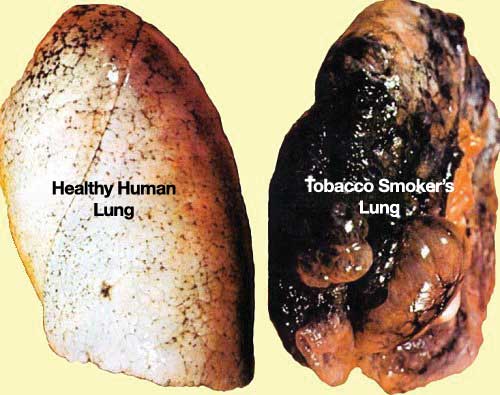What Are the Medical Consequences of Tobacco Use?
Cigarette smoking kills an estimated 440,000 U.S. citizens each year—more than alcohol, illegal drug use, homicide, suicide, car accidents, and AIDS combined. Between 1964 and 2004, more than 12 million Americans died prematurely from smoking, and another 25 million U.S. smokers alive today will most likely die of a smoking-related illness.
Cigarette smoking harms nearly every organ in the body. It has been conclusively linked to cataracts and pneumonia, and accounts for about one-third of all cancer deaths. The overall rates of death from cancer are twice as high among smokers as nonsmokers, with heavy smokers having rates that are four times greater than those of nonsmokers. Foremost among the cancers caused by tobacco use is lung cancer—cigarette smoking has been linked to about 90 percent of all cases of lung cancer, the number one cancer killer of both men and women. Smoking is also associated with cancers of the mouth, pharynx, larynx, esophagus, stomach, pancreas, cervix, kidney, bladder, and acute myeloid leukemia.
 Using advanced neuroimaging technology, scientists can see the dramatic effect of cigarette smoking on the brain and body and are finding a marked decrease in the levels of monoamine oxidase (MAO B), an important enzyme that is responsible for the breakdown of dopamine. (Source: Fowler et al., 2003)
Using advanced neuroimaging technology, scientists can see the dramatic effect of cigarette smoking on the brain and body and are finding a marked decrease in the levels of monoamine oxidase (MAO B), an important enzyme that is responsible for the breakdown of dopamine. (Source: Fowler et al., 2003)In addition to cancer, smoking causes lung diseases such as chronic bronchitis and emphysema, and it has been found to exacerbate asthma symptoms in adults and children. About 90 percent of all deaths from chronic obstructive pulmonary diseases are attributable to cigarette smoking. It has also been well documented that smoking substantially increases the risk of heart disease, including stroke, heart attack, vascular disease, and aneurysm. Smoking causes coronary heart disease, the leading cause of death in the United States: cigarette smokers are 2–4 times more likely to develop coronary heart disease than nonsmokers.
Exposure to high doses of nicotine, such as those found in some insecticide sprays, can be extremely toxic as well, causing vomiting, tremors, convulsions, and death. In fact, one drop of pure nicotine can kill a person. Nicotine poisoning has been reported from accidental ingestion of insecticides by adults and ingestion of tobacco products by children and pets. Death usually results in a few minutes from respiratory failure caused by paralysis.
Although we often think of medical consequences that result from direct use of tobacco products, passive or secondary smoke also increases the risk for many diseases. Environmental tobacco smoke is a major source of indoor air contaminants; secondhand smoke is estimated to cause approximately 3,000 lung cancer deaths per year among nonsmokers and contributes to more than 35,000 deaths related to cardiovascular disease. Exposure to tobacco smoke in the home is also a risk factor for new cases and increased severity of childhood asthma. Additionally, dropped cigarettes are the leading cause of residential fire fatalities, leading to more than 1,000 deaths each year.
 Sticky, brown tar coats the lungs of tobacco smokers. Along with thousands of other damaging chemicals, tar can lead to lung cancer and acute respiratory diseases.
Sticky, brown tar coats the lungs of tobacco smokers. Along with thousands of other damaging chemicals, tar can lead to lung cancer and acute respiratory diseases.

